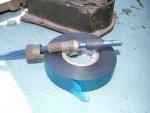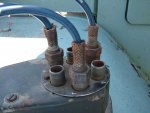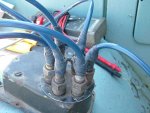Dave911
New member
- 44
- 1
- 0
- Location
- Fort Wayne, IN
I think I have read all of the threads on the forum regarding Military ignitions on the gas truck engines. I've struggled with my Continental R6602 gas engine in my 5 ton for some time. Plug fouling, back fire problems, etc. I replaced the cap and rotor, points a couple of time. Plugs 3 times etc. Nothing got a lot better. Things seem to have gotten worse over the last couple of years so I thought perhaps the plug wires? I called Memphis Equipment about a new set of plug wires - over $250 for new ones. So I decided I could screw up a couple of times trying to get standard wires to work on the military distributor. After some serious head banging I think I found a good solution and I wanted to share it so you can avoid the head banging yourself.
I took three of the old plug wires and used a cable cutter to cut off the ends and about 1" of the tube and braided portion back from the nut flange and pulled out the old wire. So I was left with some of the woven brass braid on the outside, a thin brass tube on the inside and the fitting that is soldered to the tube. (Both ends of the wires are identical) After using a tapered punch to make the brass tube and braid round again after they were sheared off via the cable cutters I found that a 7mm spark plug wire would fit down the tube perfectly. But how to secure the wire into the assembly so it doesn't fall out?
I decided to use some rubber electrical splicing tape. I stripped the ignition wire back at the end about 1/4" to expose the solid conductor (I used solid wire ignition wires) and splayed the strands in all directions, pushed on the mil ignition wire end salvaged as described. I then wrapped the rubber splicing tape around the wire about 7/8" of an inch from the end of the wire and continued to do so until the diameter of the tape wrap was just a little smaller than the hole in the top of the distributor. I then slide the wire with the tape wrapping into the distributor cap and pushed the nut down onto the rubber and threaded the assembly into the cap. The cap squeezes the rubber tape into the hole compressing it onto the wire and at the same time drives the wire against the metal contact in the cap. I snugged the nut down with a wrench and checked the wire for continuity to the arc contact inside the cap. If everything is right you should see about 5K ohms of resistance. Apparently these caps have built in resistors. Do this 6 times and you have a retrofit mil to civilian wire cap assembly.
The rubber splicing tape is unique in that it bonds to itself as you stretch it. I was concerned about the plug wire coming loose inside the cap and breaking the electrical connection, so after I did a test. I took apart the first one I put together. I backed off the nut and pulled back the mil end off the distributor and the tape had formed a solid slug of rubber in the hole. I pulled on the wire and it took a good 30+ lbs to get it our of the rubber plug that was created by the tape. So with the nut on, those plug wires are certainly not going to fall out anytime soon.
The improvement is remarkable! The truck starts and idles like never before. No sign of plug fouling yet at all. I used some Autolite resistor plugs - similar to AC Delco R46's. The plug wires I used are stranded wire set (non resistor) that I have used for farm tractors before. Belden makes them and Napa sells them. Very high quality silicone 7 mm - about $20 for a 6 cylinder set.
I should have done this years ago. Time to haul some gravel!
Time to haul some gravel!
I took three of the old plug wires and used a cable cutter to cut off the ends and about 1" of the tube and braided portion back from the nut flange and pulled out the old wire. So I was left with some of the woven brass braid on the outside, a thin brass tube on the inside and the fitting that is soldered to the tube. (Both ends of the wires are identical) After using a tapered punch to make the brass tube and braid round again after they were sheared off via the cable cutters I found that a 7mm spark plug wire would fit down the tube perfectly. But how to secure the wire into the assembly so it doesn't fall out?
I decided to use some rubber electrical splicing tape. I stripped the ignition wire back at the end about 1/4" to expose the solid conductor (I used solid wire ignition wires) and splayed the strands in all directions, pushed on the mil ignition wire end salvaged as described. I then wrapped the rubber splicing tape around the wire about 7/8" of an inch from the end of the wire and continued to do so until the diameter of the tape wrap was just a little smaller than the hole in the top of the distributor. I then slide the wire with the tape wrapping into the distributor cap and pushed the nut down onto the rubber and threaded the assembly into the cap. The cap squeezes the rubber tape into the hole compressing it onto the wire and at the same time drives the wire against the metal contact in the cap. I snugged the nut down with a wrench and checked the wire for continuity to the arc contact inside the cap. If everything is right you should see about 5K ohms of resistance. Apparently these caps have built in resistors. Do this 6 times and you have a retrofit mil to civilian wire cap assembly.
The rubber splicing tape is unique in that it bonds to itself as you stretch it. I was concerned about the plug wire coming loose inside the cap and breaking the electrical connection, so after I did a test. I took apart the first one I put together. I backed off the nut and pulled back the mil end off the distributor and the tape had formed a solid slug of rubber in the hole. I pulled on the wire and it took a good 30+ lbs to get it our of the rubber plug that was created by the tape. So with the nut on, those plug wires are certainly not going to fall out anytime soon.
The improvement is remarkable! The truck starts and idles like never before. No sign of plug fouling yet at all. I used some Autolite resistor plugs - similar to AC Delco R46's. The plug wires I used are stranded wire set (non resistor) that I have used for farm tractors before. Belden makes them and Napa sells them. Very high quality silicone 7 mm - about $20 for a 6 cylinder set.
I should have done this years ago.
Attachments
-
49.5 KB Views: 101
-
33.8 KB Views: 102
-
46.3 KB Views: 94





